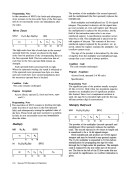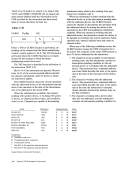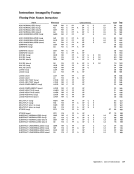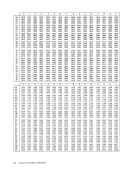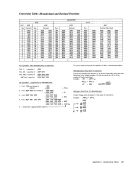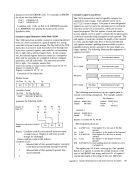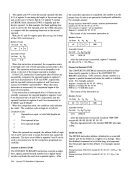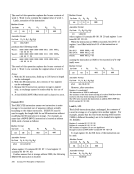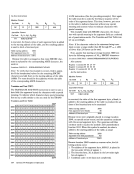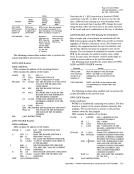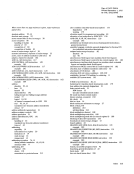performance, of the physical construction and the
use of distinct storage media are not observable by
the program.
Fetching and storing of data by theCPU are not
affected by any concurrent110 data transfer or by
concurrent reference to the same storage location by
anotherCPU. When concurrent requests to a main
storage location occur, access normally is granted in
a sequence that assigns highest priority to references
bychannels and that alternates priority between CPUs. If the first reference changes the contents of
the location, any subsequent storage fetches obtain
the new contents.
Main storage may be volatile or nonvolatile. If it
is volatile., the contents of main storage are not pre
served when power is turned off. If it is nonvolatile,
turning power off or on does not affect the contents
of main storage, provided theCPU is in the stopped
state and no references are made to main storage by
channels when power is turned off. In both types of
main storage, the contents of the keys in storage
associated with protection are not necessarily pre
servedwhen the power for main storage is turned
off.Informcltion Formats
The system transmits information between main
storage and aCPU or channel in units of eight bits,
or a multiple of eight bits, at a time. Each eight-bit
unit of information is called a byte, the basic building
block of all formats.
The bits in a byte are numbered consecutively,
left to right,0 through 7. Within any program format
or any fixed-length operand format of multiple
bytes, the bits making up the format are consecu
tively numbered from left to right, starting with the
numberO. Leftmost bits are sometimes referred to as
the "high-order" bits and rightmost bits asthe "low
order" bits.
Forpurposes of error detection, and in some
models for correction, one or more check bits are
transmitted with each byte or with a group of bytes.
The check bits are generated automatically by the
system and cannot be directly controlled by the pro
gram. References in this manual to the size of data
fields and registers exclude mention of the associated
check bits. All storage capacities are expressed in
numberof bytes provided, without regard to storage
width.
Bytes may be handled separately or grouped to
gether in fields. A hal/word is a group of two con
secutive bytes and is the basic building block of in
structions .. A word is a group of four consecutive
bytes; a doubleword is a group of eight bytes. The
14 System/370 Principles of Operation
location of any field or group of bytes is specified by
the address of its leftmost byte.
The length of fields is either implied by the opera
tion to be performed or stated explicitly as part of
the instruction. When the length is implied, the in
formation is said to have a fixed length, which can
be either one, two, four, or eight bytes.
When the length of a field is not implied by the
operation code, but is stated explicitly, the informa
tion is said to have variable field length. Variable
length operands are variable in length by increments
of one byte.
When information is placed in main storage, the
contents of only those byte locations are replaced
that are included in the designated field, even though
the width of the physical path may be wider than the
field being stored.
Addressing
Byte locations in storage are consecutively num
bered, left to right, starting with0; each number is
considered the address of the corresponding byte. A
group of bytes in storage is addressed by the left
most byte of the group. The number of bytes in the
group is either implied or explicitly defined by the
operation. The addressing arrangement uses a 24-bit
binary address to accommodate a maximum of
16,777,216 byte addresses.
Storage addressing wraps around from the maxi
mum byte address, 16,777,215, to address o. In
formation may be located partially in the last and
partially in the first location of storage and is proc
essed without any special indication of crossing the
maximum address boundary.
For purposes of addressing main storage, three
types of addresses are recognized: absolute, real, and
logical.
Absolute addresses are the lowest level of
program-recognizable addresses, and in this manual
they are considered to be the addresses of actual
storage locations.On some models, storage
configuration controls may be provided which permit
the operator to change the correspondence between
absolute addresses and the actual physical storage
locations. However, at anyone time, a physical stor
age location is not associated with more than one
absolute address.
When the multiprocessing feature is included in aCPU, an address reassignment mechanism is provid
ed that permits the first4,096 bytes of real main
storage for eachCPU to be assigned to different
absolute storage locations. This reassignment mecha
nism is called "prefixing." Most addresses generated
in theCPU are monitored by the prefixing mecha
nism and reassigned when necessary. Addresses sub-
use of distinct storage media are not observable by
the program.
Fetching and storing of data by the
affected by any concurrent
concurrent reference to the same storage location by
another
storage location occur, access normally is granted in
a sequence that assigns highest priority to references
by
the location, any subsequent storage fetches obtain
the new contents.
Main storage may be volatile or nonvolatile. If it
is volatile., the contents of main storage are not pre
served when power is turned off. If it is nonvolatile,
turning power off or on does not affect the contents
of main storage, provided the
state and no references are made to main storage by
channels when power is turned off. In both types of
main storage, the contents of the keys in storage
associated with protection are not necessarily pre
served
off.
The system transmits information between main
storage and a
or a multiple of eight bits, at a time. Each eight-bit
unit of information is called a byte, the basic building
block of all formats.
The bits in a byte are numbered consecutively,
left to right,
or any fixed-length operand format of multiple
bytes, the bits making up the format are consecu
tively numbered from left to right, starting with the
number
the "high-order" bits and rightmost bits as
order" bits.
For
models for correction, one or more check bits are
transmitted with each byte or with a group of bytes.
The check bits are generated automatically by the
system and cannot be directly controlled by the pro
gram. References in this manual to the size of data
fields and registers exclude mention of the associated
check bits. All storage capacities are expressed in
number
width.
Bytes may be handled separately or grouped to
gether in fields. A hal/word is a group of two con
secutive bytes and is the basic building block of in
structions .. A word is a group of four consecutive
bytes; a doubleword is a group of eight bytes. The
14 System/370 Principles of Operation
location of any field or group of bytes is specified by
the address of its leftmost byte.
The length of fields is either implied by the opera
tion to be performed or stated explicitly as part of
the instruction. When the length is implied, the in
formation is said to have a fixed length, which can
be either one, two, four, or eight bytes.
When the length of a field is not implied by the
operation code, but is stated explicitly, the informa
tion is said to have variable field length. Variable
length operands are variable in length by increments
of one byte.
When information is placed in main storage, the
contents of only those byte locations are replaced
that are included in the designated field, even though
the width of the physical path may be wider than the
field being stored.
Addressing
Byte locations in storage are consecutively num
bered, left to right, starting with
considered the address of the corresponding byte. A
group of bytes in storage is addressed by the left
most byte of the group. The number of bytes in the
group is either implied or explicitly defined by the
operation. The addressing arrangement uses a 24-bit
binary address to accommodate a maximum of
16,777,216 byte addresses.
Storage addressing wraps around from the maxi
mum byte address, 16,777,215, to address o. In
formation may be located partially in the last and
partially in the first location of storage and is proc
essed without any special indication of crossing the
maximum address boundary.
For purposes of addressing main storage, three
types of addresses are recognized: absolute, real, and
logical.
Absolute addresses are the lowest level of
program-recognizable addresses, and in this manual
they are considered to be the addresses of actual
storage locations.
configuration controls may be provided which permit
the operator to change the correspondence between
absolute addresses and the actual physical storage
locations. However, at anyone time, a physical stor
age location is not associated with more than one
absolute address.
When the multiprocessing feature is included in a
ed that permits the first
storage for each
absolute storage locations. This reassignment mecha
nism is called "prefixing." Most addresses generated
in the
nism and reassigned when necessary. Addresses sub-









































































































































